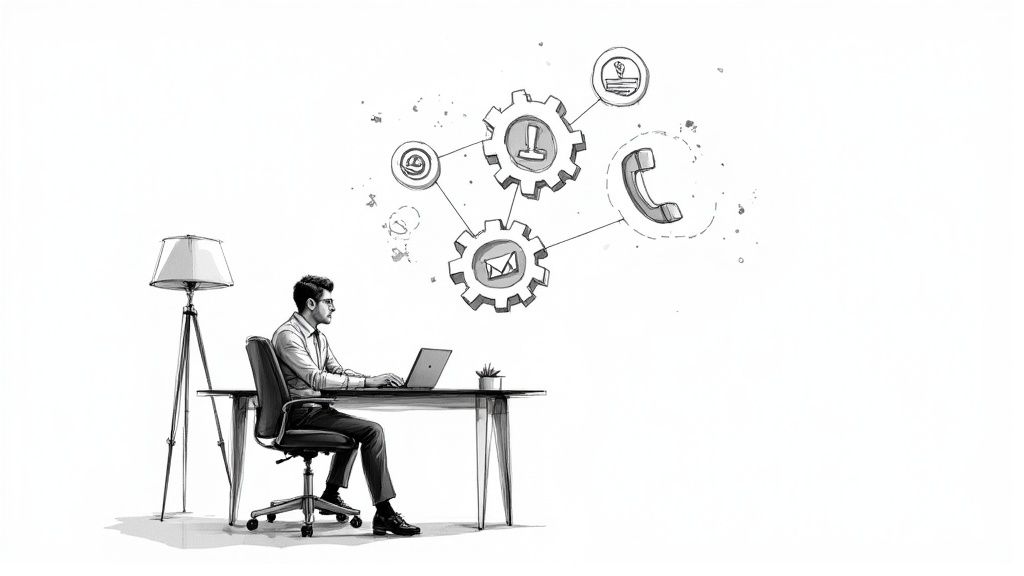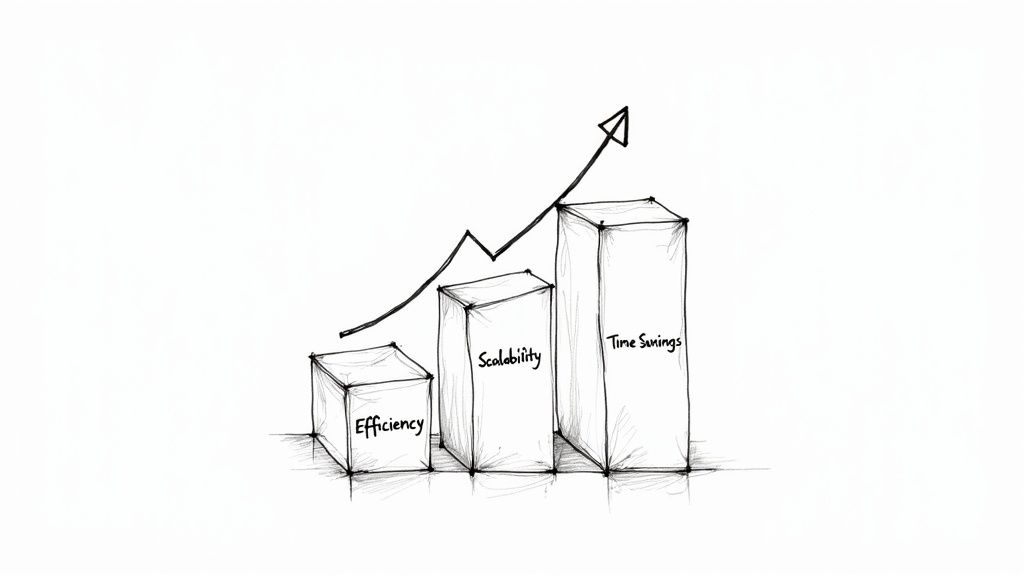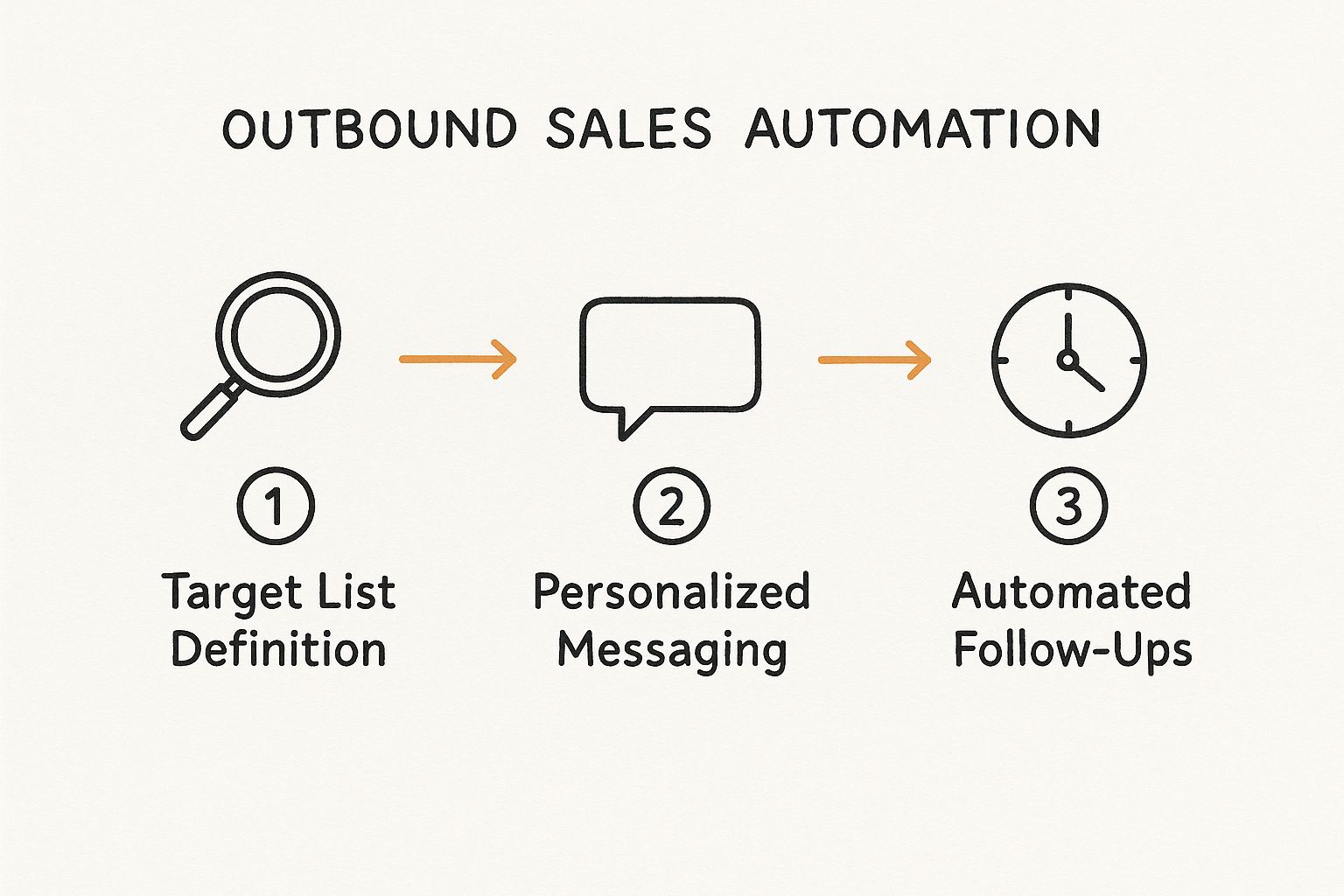Let’s be honest, “outbound sales automation” sounds a little intimidating. It conjures up images of spam bots and robotic, impersonal messages. But that’s a huge misconception.
When done right, it's the complete opposite. It’s about giving your sales team superpowers, letting them ditch the soul-crushing grunt work and focus on what they were hired to do: build relationships and close deals.
Think of it as the ultimate assistant for your sales team, one that handles all the tedious, repetitive tasks so your reps can jump in at the most critical moments.
What Is Outbound Sales Automation Really?

Let's cut through the jargon. Outbound sales automation is not about blasting a generic message to thousands of people and hoping something sticks. That's just spam with a fancy name.
True automation is a powerful engine for scaling intelligent, personalized outreach. It allows you to connect with more of the right people in a more meaningful way.
Imagine your best sales development reps (SDRs) are detectives. Their real job is to uncover clues, identify high-value prospects, and build a compelling case. But what do they spend most of their day doing? Tedious admin work—hunting for contact info, logging calls in a spreadsheet, and manually sending follow-up reminders.
It's a massive time sink. In fact, research shows the average sales rep spends only about 22% of their time actually selling. The rest is eaten up by data entry and other administrative tasks. You can find more eye-opening sales productivity stats that highlight this exact problem. Automation is the direct solution.
How Automation Transforms Daily Sales Tasks
To see the real-world impact, it helps to compare the old way of doing things with the new, automated approach. You'll quickly see how much time and energy is being wasted on low-value activities that a machine could handle effortlessly.
The table below breaks down the shift from a manual grind to a smooth, automated workflow for common sales tasks.
It's a night-and-day difference. By taking over the predictable, rule-based work, automation frees up your team's mental bandwidth for the stuff that actually moves the needle.
Automation handles the flight plan—finding prospects, sending initial emails, and logging data—so your sales reps can focus their energy on high-value conversations and strategic thinking. It’s the foundation of a predictable revenue engine.
This isn’t about replacing your people; it's about amplifying their talent. A great salesperson's magic lies in their ability to empathize, build rapport, and navigate complex human conversations. Sales automation simply clears their plate of the mundane tasks that get in the way, letting their true strengths shine.
Building Your Sales Automation Tech Stack

A killer outbound sales automation strategy isn't about finding one magic tool that does it all. It’s about building an interconnected system—a tech stack—where every piece has a specific job and talks to the others without a hitch.
Think of it like putting together a high-performance pit crew for your sales team. Each person has a specialized role, but they all work in perfect sync to win the race. Let's break down the essential building blocks of a modern sales automation tech stack.
Prospecting and Lead Intelligence Tools
Your prospecting tools are the scouts for your entire operation. Their main job is to find high-potential leads that perfectly match your ideal customer profile (ICP). Instead of you spending hours manually digging through the internet, these platforms can build highly targeted lists in minutes.
But today's prospecting tools do more than just find names and emails. They dig up the kind of business intelligence that makes personalization not just possible, but powerful.
- Firmographic Data: This is the basic stuff—company size, industry, location, and annual revenue.
- Technographic Data: These tools can sniff out the specific software and technologies a company is already using.
- Buying Signals: This is where it gets interesting. They track key events like a new executive hire, a recent funding round, or a hiring surge in a specific department. These are all signals that often point to an immediate need.
Getting this initial data right is the foundation of any successful outbound sales automation campaign. Without accurate, relevant info, even the slickest outreach tools will fall flat.
A great prospecting tool doesn't just hand you a list of contacts; it gives you the context you need to start a real conversation. It’s the difference between a stone-cold call and a warm introduction.
Email Sequencing and Outreach Platforms
Once you have your list of qualified prospects, email sequencers become your relentless communicators. These platforms run multi-touch, multi-channel outreach campaigns on autopilot, making sure no prospect ever slips through the cracks.
You can design an entire sequence of steps—an initial email, a follow-up three days later, a LinkedIn connection request, and another email a week after that. The platform takes care of the execution, and it's smart enough to stop the sequence the moment a prospect replies.
To really get how these campaigns come to life, check out our guide on https://www.plusvibe.ai/cold-email-automation. These tools are absolutely crucial for staying persistent without being annoying.
The CRM Integration Hub
Your Customer Relationship Management (CRM) system is the absolute, non-negotiable central nervous system of your tech stack. It's your single source of truth, holding every interaction, data point, and conversation you have with prospects and customers.
A seamless CRM integration is make-or-break. When your prospecting tool finds a new lead, it should automatically pop a new record into the CRM. When your sequencer sends an email or books a meeting, that activity needs to be logged instantly. This gives you a true 360-degree view of every lead.
This integration kills manual data entry, a massive time-waster and a huge source of errors for sales reps. It also means your account executives have the full story on a lead before they even pick up the phone. For a great example of how powerful these connections can be, see how some companies are mastering HubSpot Jira automation to unify their teams.
AI-Powered Analytics and Optimization
The final piece of the puzzle is your strategist: AI-powered analytics. This is the component that looks at the performance of your outreach campaigns and tells you what’s hitting the mark and what’s not.
AI can crunch thousands of data points to deliver insights a human could easily miss.
- A/B Testing: You can automatically test different subject lines, email copy, and calls-to-action to see what actually gets replies.
- Optimal Send Times: AI analyzes engagement data to figure out the perfect day and time to send emails to different segments of your audience.
- Performance Dashboards: Track the metrics that matter—open rates, click-through rates, reply rates, and meetings booked—giving you a clear, no-fluff picture of your campaign's ROI.
When you bring these four components together, you build a well-oiled machine that turns raw data into qualified meetings. This frees up your sales team to do what they do best: closing deals.
How Automation Boosts Sales Productivity

Let's cut through the noise. Beyond the tools and tech, the real question is why you should actually care about outbound sales automation. The answer is surprisingly simple: it completely changes the game for your team.
You’re not just saving a few minutes here and there. You're freeing your reps from the soul-crushing grind of data entry and turning them back into strategic relationship builders—the job they were hired to do.
To see what this really looks like, let's look at a day in the life of two different sales development reps (SDRs).
A Tale of Two Sales Reps
First up, meet Alex. Alex is doing things the old-school way. His morning is a frantic blur of bouncing between spreadsheets, manually digging through LinkedIn profiles, and copy-pasting prospect info into the CRM. By lunchtime, he's barely sent a handful of semi-decent emails, and his follow-up plan is a hot mess of calendar reminders he’ll probably ignore.
Now, meet Jordan. Jordan’s team gets it. They use outbound sales automation. She starts her day with a clean, prioritized list of high-intent leads that the system pulled together overnight. Her pre-built email sequences, already fine-tuned with smart personalization, are out the door and working for her.
Instead of drowning in admin, Jordan spends her morning actually talking to warm leads and prepping for meetings that automation already booked on her calendar. While Alex is still logging his morning tasks, Jordan is deep in conversation with qualified prospects. The contrast couldn't be clearer. Automation systematically kills the low-value work that torpedoes productivity.
Reclaiming Time and Cranking Up the Volume
The daily sales grind is packed with time sinks that automation is built to handle. By taking over these repetitive chores, it directly pumps up productivity and drives real results.
Here’s how:
- More Time Selling: This is the big one. When reps aren't buried in admin work, they can spend their time on what matters—talking to people, understanding their problems, and building genuine connections.
- Faster Lead Response: In sales, speed is everything. Automation makes sure every new lead gets a quick, relevant touchpoint, massively boosting your odds of engaging them before a competitor does.
- Supercharged Pipeline: A single rep using an automated system can manage a much larger pipeline without dropping the ball on personalization or letting leads go cold. You can scale your outreach without having to scale your headcount at the same pace.
This isn't just a hunch; the numbers tell the story. One study found that companies using sales automation platforms see a 10-15% jump in sales productivity. The same research showed their teams spend 21% less time on admin and 17% more time actively engaging with prospects. You can discover more insights about sales automation productivity and what it can do for your team.
By automating the predictable, you empower your team to excel at the unpredictable. You’re not just making them faster; you're making them smarter, more strategic, and ultimately, more successful.
Think of outbound sales automation as a force multiplier for your team. It handles the monotonous stuff that computers are great at, freeing up your talented humans to focus on the nuance, creativity, and empathy that actually close deals and build lasting relationships. It's the secret weapon for hitting peak performance.
Using AI for Hyper-Personalized Outreach
If standard automation is the engine of your outbound sales machine, think of AI as the high-octane fuel and the advanced GPS rolled into one. It takes your strategy beyond just checking off repetitive tasks and into the realm of smart, data-driven outreach that feels genuinely personal. This is where we leave basic templates behind and start crafting messages that are almost impossible for prospects to ignore.
Forget seeing AI as some far-off, futuristic concept. It's a practical tool that acts like a master copywriter and a brilliant strategist for every single lead in your pipeline. It digs through enormous amounts of data to figure out not just who to talk to, but exactly how and when to talk to them for the biggest impact.
It’s the difference between a mass-produced, one-size-fits-all suit and a custom-tailored one. The first might get the job done, but the second commands attention, feels right, and leaves a lasting impression. That’s the power AI brings to outbound sales automation.
From Automation to True Intelligence
Traditional automation is great at following rules. For instance, "If a prospect doesn't reply in three days, send follow-up email #2." It's efficient, sure, but it completely lacks nuance. AI adds a layer of thinking, letting the system make decisions based on context and data, not just pre-written commands.
Here’s how AI fundamentally changes the game:
- Intelligent Lead Analysis: AI can scan a prospect's LinkedIn profile, recent company news, and online posts to pinpoint specific challenges or recent wins. This isn't just data—it's the perfect kindling for a conversation-starting message.
- Predictive Send-Time Optimization: Instead of just guessing the best time to hit "send," AI analyzes past engagement from similar prospects. It predicts the precise moment an individual is most likely to actually open and read your message.
- Buying Signal Identification: AI is always scanning the web for critical buying signals. Think things like a company hiring for a new role, a fresh round of funding, or a key executive talking about a relevant problem online.
This shift turns your outreach from a monologue into a real dialogue. You’re no longer just shouting at your prospects; you’re starting a relevant conversation based on what’s happening in their world, right now.
Crafting Hyper-Personalized Messages at Scale
The age-old sales dilemma has always been balancing quality with quantity. How do you send thousands of emails without sounding like a generic robot? This is exactly where modern AI, especially Large Language Models (LLMs), shines.
AI doesn't just slot a
{{first_name}}and{{company_name}}into a stale template. It generates entire sentences and paragraphs that refer to specific, timely details, creating a message that feels 1-to-1, even when sent by the thousands.
For example, an AI-powered system can craft an opening line like: "Saw the great news about your Series B funding on TechCrunch—congratulations! As you scale your engineering team, managing cloud costs often becomes a new challenge." This kind of specific, timely personalization used to take hours of manual research for every single prospect. You can explore more ways to do this in our deep dive into AI email personalization.
The impact of this tech is clear. The outbound sales automation market is on track to hit $16 billion by 2025, a surge driven largely by these AI capabilities. We've seen studies showing that AI-driven personalization can boost conversion rates by up to seven times, and signal-based selling often adds a 10-20% lift in ROI.
Monitoring and Refining AI Performance
Rolling out AI isn't a "set it and forget it" task. To make sure your AI-powered outreach stays effective, authentic, and on-brand, you have to keep a close eye on it. These models are powerful, but they need human oversight to perform at their best and avoid sending messages that sound off-key or just plain weird.
This is where specialized tools become essential. For teams using advanced AI models, getting to grips with LLM monitoring tools is non-negotiable. These platforms help you track the quality of the content your AI is generating, measure its impact on your open and reply rates, and fine-tune your prompts and models over time. This feedback loop is what keeps your hyper-personalized outreach sharp and delivering maximum return.
Right, so you understand what outbound sales automation is, but how do you actually get it working for you? Theory is one thing, but execution is what brings home the bacon.
Moving from concept to a running, optimized system requires a solid plan. Think of it like building a high-performance engine. You can't just toss a bunch of parts in a box and hope it starts. You need a blueprint. This roadmap breaks down the process into clear, manageable steps to get you from zero to a fully operational system that actually pays for itself.
Phase 1: Define Your Goals And Audit Your Process
Before you even think about looking at software, you need to know what you're aiming for. What does "success" look like in real numbers? Vague goals like "get more leads" just won't cut it. You have to get specific.
- Set Clear Objectives: Are you trying to boost meetings booked by 30%? Maybe you want to slash manual data entry by 10 hours per rep each week. Or perhaps the goal is to get your lead response time under five minutes. These are the kinds of quantifiable goals that will guide every decision you make.
- Audit Your Current Workflow: Get a whiteboard and map out your current outbound sales process, from the first touchpoint to the last. Where are the biggest time-wasters? The manual bottlenecks? The spots where good leads just seem to fall off the map? This audit is your treasure map—it shows you exactly where automation will make the biggest difference.
Don't skip this planning phase. It's hands-down the most critical step. Studies consistently show that teams who tie their automation directly to specific KPIs are the ones who see massive productivity jumps. If you skip this, you’re just automating the chaos you already have.
Phase 2: Select Your Tools And Build Your Stack
With your goals and pain points clearly defined, now you can start shopping for the right tools. Your tech stack is the heart of your outbound sales automation strategy, so the name of the game is finding tools that play nicely together and solve your specific problems.
When you're evaluating different platforms, it's easy to get dazzled by flashy features. Use a simple checklist to stay grounded and compare your options objectively.
Outbound Automation Tool Selection Checklist
Use this checklist to evaluate and compare different outbound sales automation tools to find the best fit for your team's needs and budget.
Don't rush this decision. Get on demos, sign up for free trials, and talk to current users to get the real, unfiltered scoop on each platform's pros and cons.
Phase 3: Construct And Integrate Your First Sequence
Alright, it’s time to get your hands dirty and build your first automated outreach campaign. In the sales world, we call this a "sequence" or "cadence." It’s simply a pre-planned series of touchpoints (emails, LinkedIn messages, etc.) designed to engage a prospect over a set period.
This is where your strategy comes to life. You're defining your target, crafting your messages, and then letting the machine handle the persistent follow-up so you don't have to.

As you can see, each stage builds on the one before it, creating a structured flow that keeps prospects moving forward and ensures no one gets forgotten.
A great sequence is the perfect marriage of automation and human insight. The software does the heavy lifting, but your strategy, messaging, and timing are what make it connect with another human being. It's your sales playbook, turned into code.
Here are the key parts to nail:
- Define Your Target Segment: Start small. Grab a very specific group of prospects you identified during your audit.
- Craft Your Messaging: Write compelling, value-first copy for every step. Use personalization tokens to pull in prospect data and make it feel 1-on-1.
- Set Your Timing: Decide on the ideal wait time between each touch. A good starting point is usually 2-3 business days.
- Integrate with Your CRM: This is non-negotiable. Make sure every single action—sends, opens, replies—is automatically logged in your CRM. This gives you a single, reliable record of every interaction. For a deeper dive on this, our guide on how to automate sales process has some great tips.
Phase 4: Launch, Monitor, And Optimize
With your first sequence built and plugged in, you're ready to hit "go." But this isn't a crock-pot—you can't just set it and forget it. The final phase is a constant loop of launching, monitoring, and tweaking.
Kick things off with a small pilot group. This is your safety net to catch any technical hiccups or awkward messaging before you blast it out to your entire list.
Once it's live, watch your key metrics like a hawk. Are your open rates in the gutter? Time to test new subject lines. Not getting replies? Your call-to-action probably needs a rewrite. The best automation strategies are living, breathing systems. They evolve based on real-world data, constantly being refined to get you better and better results over time.
Common Automation Pitfalls to Avoid
It’s easy to get excited about outbound sales automation. But it’s not a magic wand. Treating it like a "set it and forget it" solution is the fastest way to torch your brand's reputation and push potential customers away.
Think of automation like a high-performance car. In the right hands, it wins races. But without the right skill and maintenance, it’s just a crash waiting to happen. To drive real growth, you first need to know where the most common pile-ups happen.
The Robotic Over-Automation Trap
This is the big one. It’s what happens when teams get so jazzed about efficiency that they automate everything, stripping any shred of humanity from their outreach. The result? Cold, generic messages that prospects can spot from a mile away.
A classic example is a sequence that blasts out five identical, impersonal follow-ups. It doesn't acknowledge the person's industry, their role, or anything unique about them. It just screams, "You're another number on my list," and gets you a one-way ticket to the spam folder.
The point of outbound sales automation isn't to kill human interaction—it's to create more of it. Let automation handle the heavy lifting of initial outreach and follow-ups, but the end goal should always be to spark a real, one-on-one conversation.
Neglecting Data Quality and Hygiene
Let's be blunt: your automation is only as good as the data you feed it. Using dirty, old, or just plain wrong data is like building a house on a swamp. It’s going to sink.
This isn’t just about deliverability; it's about credibility. Imagine sending a hyper-personalized email that confidently mentions a prospect's old company or gets their job title completely wrong. You don’t just look sloppy—you look like you haven't done the bare minimum. Your "personalization" instantly backfires and kills any trust you hoped to build.
Keeping your CRM clean and your contact info validated isn't just a chore; it's non-negotiable. This is the foundation for everything else, including effective automated lead qualification, which ensures your team only talks to people who actually matter.
Ignoring Privacy and Compliance Rules
In the rush to get campaigns out the door, it’s dangerously easy to blow past critical privacy laws like GDPR in Europe or CAN-SPAM in the U.S. These aren't just friendly suggestions—they're laws with teeth, and the fines can be massive.
A common mistake is burying the opt-out link or failing to include one at all. Another is being vague about who you are and why you're reaching out. Blasting out automated emails without playing by the rules is a surefire way to get hit with penalties and do lasting damage to your brand. Make sure every single campaign is compliant from the ground up.
Answering Your Top Automation Questions
When teams first start poking around outbound sales automation, a few key questions and totally valid concerns almost always pop up. Let's tackle them head-on, clear up any confusion, and give you the confidence to move forward.
Will Automation Replace My Sales Reps?
This is the big one, and the answer is a hard no. The point of automation isn't to replace your talented salespeople—it's to supercharge them.
Think of it this way: automation takes over the soul-crushing, repetitive tasks like manual data entry and basic follow-ups. This frees up your reps to do what humans are best at: building real relationships, thinking strategically, and closing those big, complex deals. You're not replacing your star players; you're giving them a world-class support crew.
Outbound sales automation amplifies a rep's skills; it doesn't make them obsolete. It systematically removes the administrative burden that bogs down even the most effective sellers, allowing their talent to shine.
How Can I Keep My Outreach From Sounding Robotic?
This is a huge concern, and rightly so. Nobody wants to be that company sending generic, robotic emails. The secret is deep personalization and sticking to your authentic brand voice.
Modern AI-powered tools go way beyond a simple {{first_name}} tag. They can analyze a prospect's LinkedIn activity, company news, and other buying signals to help you craft messages that are genuinely relevant and timely. When you focus on a prospect's specific pain points or a recent company win, your automated outreach can actually feel more personal than a generic email you dashed off by hand. There are many surprising ways outbound sales automation can skyrocket your pipeline when you get personalization right.
What Metrics Should I Track For Success?
Open and click rates are fine, but they don't pay the bills. The metrics that truly matter are the ones tied directly to revenue. You'll want to keep a close eye on these:
- Reply Rate: This is your first real gut check. It tells you if your messaging is actually hitting the mark and starting conversations.
- Meetings Booked: The clearest sign that your outreach is generating real, qualified interest. This is where the magic starts.
- Pipeline Generated: The ultimate measure of your ROI. This is the total dollar value of the opportunities your automation efforts have created.
Ready to transform your outreach with AI that actually works? PlusVibe offers a powerful, intuitive platform to build hyper-personalized campaigns, ensure top deliverability, and turn cold prospects into qualified meetings. Start scaling your pipeline today.














































.jpeg)


.png)























































